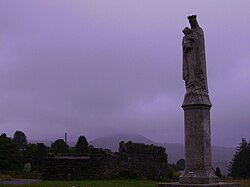Penrhys
Penrhys is a village in the county borough of Rhondda Cynon Taf, Wales, situated on a hillside overlooking both valleys of Rhondda Fawr and Rhondda Fach. It is situated around 1,100 ft above sea level and is a district of Tylorstown. Until the late 16th century, Penrhys was one of the holiest sites for Christian pilgrims in Wales.
The site of Penrhys has a rich religious history dating back to mediaeval times, though few settlements other than farmsteads can be traced to the area. Penrhys is significant for a mediaeval monastery, the holy shrine of "Our Lady" built at the holy spring of Ffynnon Fair. During the early 16th century the antiquarian John Leland wrote during his visit to the area that he saw "Penrise Village, where the Pilgrimage was", suggesting that a settlement had built up in the area. In 1538 the shrine was destroyed during the English Reformation, and the area appeared to fall into decline. With the arrival of industrialisation in the Rhondda Valley during the 19th century interest in the religious history of Penrhys increased. An archaeological dig at the old chapel was carried out in 1912 and a new statue of the Virgin Mary was unveiled in 1953. In February 1927 the first burial took place at Penrhys cemetery.
In 1904 the mining population of Rhondda was over 110,000 and still expanding rapidly. Although a 'fever hospital' had been constructed in nearby Ystrad, the threat of smallpox had become a concern to the Medical Officer of Health, who recommended a separate containment site. In 1906 the Health Committee purchased three acres of land at Penrhys, chosen for its accessibility to both Rhondda valleys and its distance from other habitable buildings. The smallpox hospital was completed in 1907 and at first served the Rhondda and later all of South Wales. In the 1970s the building was deemed unnecessary and was burnt to the ground by the South Wales Fire Service in 1971.
In 1927 Penrhys was chosen as the starting point for 'Red Sunday in Rhondda Valley' hunger march. The march was organised by the South Wales Miners' Federation and the Rhondda District, but lost support due to opposition from the TUC. It was supported by the Communist party and the march went ahead supported by 270 marchers.
...
Wikipedia


